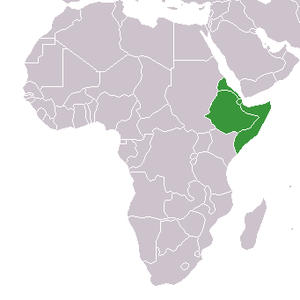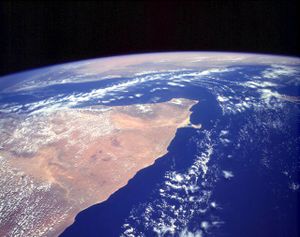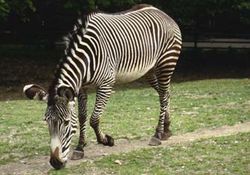Horn of Africa
2007 Schools Wikipedia Selection. Related subjects: African Geography
The Horn of Africa (alternatively Northeast Africa, and sometimes Somali Peninsula) is a peninsula of East Africa that juts for hundreds of kilometers into the Arabian Sea, and lies along the southern side of the Gulf of Aden. It is the easternmost projection of the African continent.
It indeed resembles in outline the horn of an animal — perhaps especially, the horns of the Black Rhinoceros, whose historic range includes parts of Ethiopia:
- Its orientation relative to the Equator approximates that of either rhino horn relative to the ground.
- The angle between its northern and southeastern coasts approximates that at the tip of the rhino's upper horn.
- The concavity of its northern coast, and convexity of its southern, echo similar curvatures on the rhino's lower horn.
The term also refers to the greater region containing the countries of Djibouti, Ethiopia, Eritrea and Somalia. As such, it covers approximately 2,000,000 km² and is inhabited by about 86.5 million people. Sudan and Kenya are sometimes included as well.
Greater Somalia is a nationalist goal to create a unified Somali state in the Horn of Africa, in the former and present states referred to by the five points of the star in the national flag of Somalia since that country's independence: the former British and Italian colonies of present Somalia, the former French Somaliland (now Djibouti), the Ogaden in Ethiopia, and the North Eastern province in Kenya.
Geography and climate
The Horn of Africa, almost equidistant from the Equator and the Tropic of Cancer, is an arid region.
Socotra is a small island off the coast of Somalia, in the Indian Ocean, that is considered to be part of Africa. Its size is 3,600 square km. It is a territory of Yemen, the southernmost country on the Arabian peninsula.
History
Ancient history
The Kingdom of Aksum (also known as "Axum") was an African state located in Ethiopia, Eritrea, northern Somalia and Yemen that thrived between the 1st and 7th centuries. Due to the Horn's strategic location, it has been used to restrict access to the Red Sea in the past.
The region was also a source of biological resources during the Antiquity: The ancient Egyptians, Greeks and Romans sent expeditions to the region for frankincense, myrrh, dragon's blood or cinnabar and took these commodities back along the Incense Route. Therefore the Romans called this region Regio Aromatica.
Modern history
The Horn of Africa is a region continuously in crisis. Ethiopia occupies a predominant position in the Horn because of its demographic importance: about 85% of the area's population live in this country. Yet Ethiopia's history is largely marked by conflicts between Muslims and Christians for resources and living space, as well as between nationalism and Marxism-Leninism in the modern times. The rest of the region also faces continuous wars: a civil war erupted in Somalia in 1977, resulting in the country having had no functioning national government since 1991. Sudan, with the Sudanese Civil War, represents another important source of instability for the whole region. Conflicts have also occurred in Djibouti and Eritrea.
Moreover, the region is regularly stricken by natural catastrophes, such as droughts (in Ethiopia) or flood (Somalia) that hit rural areas particularly hard. As a result, the region has some of the world's highest levels of malnutrition and is continuously loomed by a major humanitarian crisis. Between 1982 and 1992, about two million people died in the Horn of Africa due to this combination of war and famine.
The Horn of Africa, since 2002, has been a major focus of attention by the United States, France, Germany, and eleven African nations regarding the so-called War on Terrorism.
Culture and ethnicity
The countries of the Horn of Africa are culturally linked together. Local people have been using the plow for cultivation and kept the Arabian dromedary as domestic animals for a long time. Some important ethno-linguistic groups in the Horn of Africa are:
- In Djibouti: the Afar (Danakil) and the Somali (Issa)
- In Eritrea: the Bilen, the Afar, the Beni-Amer ( Beja), the Hedareb, the Kunama (Baza), the Nara (Nialetic), the Saho (Irob), the Rashaida, the Tigre, and the Tigrinya. The Jebertis are Muslim Tigrinyas who consider themselves as a separate ethnicity, but are not recognized by other sources.
- In Ethiopia: Amharas, Afars, Agaw groups, Gurages, Hamers, Hararis (also Hadere or Adere), the Irob (Catholic Sahos) Oromos, Saho, Sidamas, Somalis, and Tigrayans, as well as many other small groups (see also ethnicities listed at Southern Nations, Nationalities, and People's Region).
- In Somalia: the Dabarre, the Digil-Rahawlin, the Garre, the Jiiddu, the Shambaara (Gosha), the Somali, the Swahili (Baraawe) and the Tunni.
- In Sudan: the Anuak, the Atwot, the Bale, the Beni-Amer (Beja), the Bisharin (Beja), the Burun (Barun, Borun), the Dar Fur Daju, the Dar Sila Daju, the Didinga (Xaroxa, Toil), the Fedicca-Mahas, the Nubian, the Fulani (Sudanese Fula), the Fur (Furawi), the Chulfan (Gulfan), the Gule (Fung, Hameg), the Hadendoa (Beja), the Hamar, the Hausa Fulani, the Ingessana (Tabi), the Kanga (Abu Sinun), the Yerwa Kanuri, the Katla (Akalak), the Kenuzi-Dongolese, the Nubi, the Central Koma (Komo), the Krongo Nuba, the Maba (Borgu, Mabang), the Maban-Jumjum (Maben), the Mararit (Ablyl, Ebiri, Masalit), the Masalit, the Mesakin (Masakin), the Midob (Miedob, Tidi), the Nyimang (Nyima, Ama), the Par (Lokoro), the Rufaa (Rufalyin), the Shatt (Daju), the Shatt (Mandul), the Sungor (Assagori), the Tagale (Taqalawin), the Temein, the tigre, the Tira (Thiro), the Tulishi and the Zaghawa.
Economy
States of the region depend largely on a few key exports:
- Sudan: Cotton 50% of total exports.
- Ethiopia: Coffee 80% of total exports.
- Somalia: Bananas and livestock over 50% of total exports.
Ecology
The Horn of Africa is a UNESCO Biodiversity Hotspot and one of the two entirely arid ones. However the Horn of Africa suffers largely from overgrazing and only 5% of its original habitat still remains. On Socotra, another great threat is the development of infrastructure.
Fauna
About 220 mammals are found in the Horn of Africa. Among threatened species of the region, we find several antelopes such as the beira, the dibatag, the silver dikdik and the Speke’s gazelle. Other remarkable species include the Somali wild ass, the desert warthog, the Hamadryas Baboon, the Somali pygmy gerbil, the ammodile and the Speke’s pectinator. The Grevy's zebra is the unique wild equid of the region.
Some important bird species of the Horn are the Bulo Burti boubou, the golden-winged grosbeak, the Warsangli linnet or the Djibouti francolin.
The Horn of Africa holds more endemic reptiles than anywhere else in Africa, with about 90 species over about 285 found exclusively here. Among endemic reptile genera, there are Haackgreerius, Haemodracon, Ditypophis, Pachycalamus or Aeluroglena. Half of these genera are uniquely found on Socotra. Unlike reptiles, amphibians are poorly represented in the region.
There are about 100 species of freshwater fish in the Horn of Africa, about 10 of which are endemic. Among the endemic, we find the cave-dwelling Somali blind barb and the Somali cavefish.
Flora
It is estimated that about 5,000 species of vascular plants are found in the Horn, about the half of which is endemic. Endemism is most developed in Socotra and Northern Somalia. The region has two endemic plant families: the Barbeyaceae and the Dirachmaceae. Among the other remarkable species, there are the cucumber tree found only on Socotra, the Bankoualé palm, the Yeheb nut or the Somali cyclamen.


